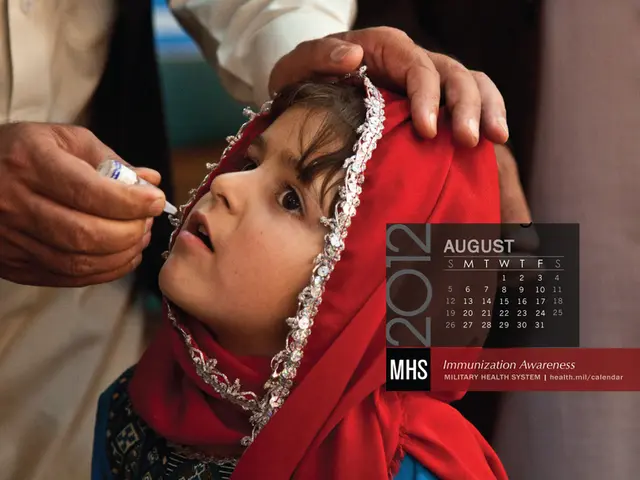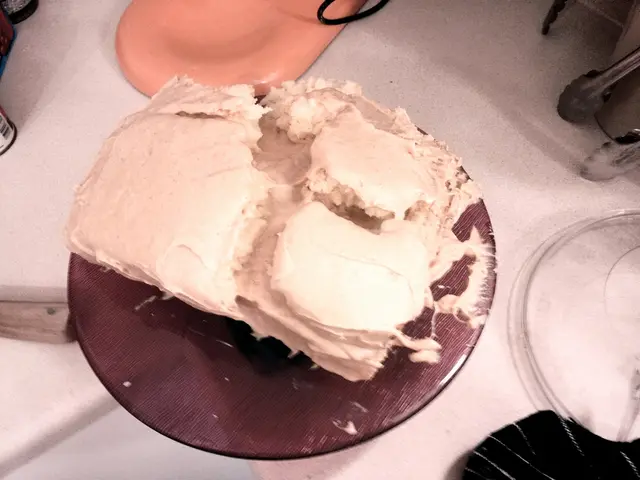Differentiating Age Spots from Skin Cancer: A Guide for Identification
Age spots, those unsightly blemishes that pop up as we age, can give off a false impression of skin cancer. But don't fret, these spots are harmless and don't need your attention.
Skin cancer, on the other hand, is a serious concern. While both conditions tend to form on sun-exposed areas, understanding their differences can help you spot the warning signs. Keep an eye out for key characteristics like texture, color, and placement.
Let's dive into the nitty-gritty of age spots and skin cancer and learn how these conditions differ in appearance, symptoms, diagnosis, and treatment.
What sets age spots and skin cancer apart?
Age spots, or solar lentigines, arise due to the body producing excessive melanin to shield the skin from sun damage. These spots are usually flat, round or oval, and sport a more uniform color compared to skin cancer lesions. Age spots develop on sun-exposed areas like the face, hands, and shoulders and tend to be between a few millimeters to centimeters in size.
Skin cancer is a real threat. It occurs when skin cells suffer damage from UV radiation or other environmental or genetic factors, causing them to grow and spread aggressively. Common types of skin cancer are basal cell carcinoma, squamous cell carcinoma, and melanoma.
Can age spots transform into skin cancer?
Don't worry - age spots cannot transform into skin cancer. However, another kind of precancerous growth called actinic keratosis can resemble age spots. If left untreated, this precancerous growth may turn into skin cancer[1][2][5].
What are the differences in symptoms?
Age Spot Symptoms
Age spots are:
- Flat and smooth
- Yellow, brown, or gray
- Defined with clear borders
- Between a few millimeters or centimeters in size
- On sun-exposed areas such as the:
- Face
- Hands
- Shoulders
- Feet
- Arms
- Back
Age spots may lessen in winter but become more prominent in summer when skin is exposed to more sunlight.
Skin Cancer Symptoms
Skin cancer symptoms vary depending on factors such as cancer type. However, signs of a cancerous growth can include:
- Asymmetrical shape
- Blurred or irregular edges
- Changing size, color, or shape
- Multiple colors on the same spot
- Pink, blue, purple, black, or brown coloring
- Red, raised patches
- Firm, pale or yellow patches similar to scars
- Pain, itching, oozing, or bleeding
- Crusty or scaly patches
- Raised edges that lower in the middle
Actinic keratosis can resemble age spots but presents as raised, rough, or scaly patches, red, gray, pink, or skin-colored patches, or flat scaly patches that look similar to age spots. Actinic keratosis can also manifest as scaly, rough bumps that appear in clusters similar to acne[1][2][4].
When should you contact a doctor?
Generally, reach out to a doctor if you notice any unusual skin changes that aren't normal for you. It's crucial to catch skin cancer early, as this improves treatment outcomes. Seek medical advice if a mark on the skin:
- Changes in color, shape, size, or location
- Looks different from other marks on the skin
- Itches, crusts, scabs over, or bleeds and does not heal within four weeks[1][2][4]
Diagnosis
A dermatologist or doctor will perform a physical examination to diagnose age spots. Depending on the clinical findings, they may also perform a skin biopsy to test for skin cancer or actinic keratosis[1][2][4].
Treatment
Age spots require no medical treatment since they pose no harm. However, some people may seek treatment to minimize their appearance. Cosmetic procedures like laser treatments, cryosurgery, microdermabrasion, and chemical peeing can help fade age spots[5].
Treatment for skin cancer depends on factors such as cancer type, size, and location. Surgical excision or Mohs surgery are common for basal cell and squamous cell cancers. Topical therapies, radiation therapy, chemotherapy, immunotherapy, or systemic medication may also be used[2][4].
Key Takeaways
Age spots and skin cancer are two different conditions, but they can share similar appearances. By understanding their key differences in appearance, symptoms, diagnosis, and treatment, you can feel more confident in identifying potential skin issues.
Regularly monitor your skin for any changes, especially if you've been exposed to excessive sunlight. Act quickly if any unusual growths appear, and consult a medical professional for guidance. Early detection and prompt treatment can significantly improve your chances for successful treatment and skin health[1][2][4][5].
[1] Skin Cancer info (n.d). American Academy of Dermatology Association. Retrieved from https://www.aad.org/public/diseases/skin-cancer/skin-cancer-types/basal-cell-skin-cancer
[2] Skin Cancer Facts (2021). American Cancer Society. Retrieved from https://www.cancer.org/cancer/skin-cancer/skin-cancer-facts.html#:~:text=How%20common%20is%20skin%20cancer,-Skin%20cancer%20is&text=Skin%20cancer%20is%20the%20fifth,a%20cause%20of%20death%20worldwide.
[4] Actinic Keratosis info (n.d). American Academy of Dermatology Association. Retrieved from https://www.aad.org/public/diseases/scaly-skin/actinic-keratosis
[5] Age Spots: What You Need to Know (2021). Mayo Clinic. Retrieved from https://www.mayoclinic.org/diseases-conditions/age-spots/symptoms-causes/syc-20369282
- Age spots and skin cancer are two distinctive medical conditions, each with their unique characteristics, symptoms, and treatments.
- While age spots are harmless and usually appear flat, round or oval with a more uniform color, skin cancer can be a serious concern and may exhibit irregular edges, changing size, color, or shape, and various other symptoms.
- It is important for seniors to be aware of the differences between age spots and skin cancer, as well as other skin conditions, to ensure early detection and prompt treatment of skin cancer.
- Regular skin-care routines, including routine check-ups and health-and-wellness practices, can help seniors keep an eye on any potential skin conditions and address them accordingly.
- Visiting a dermatologist or a medical professional experienced in oncology and other skin-related medical-conditions is crucial for diagnosing and treating skin cancer effectively.








